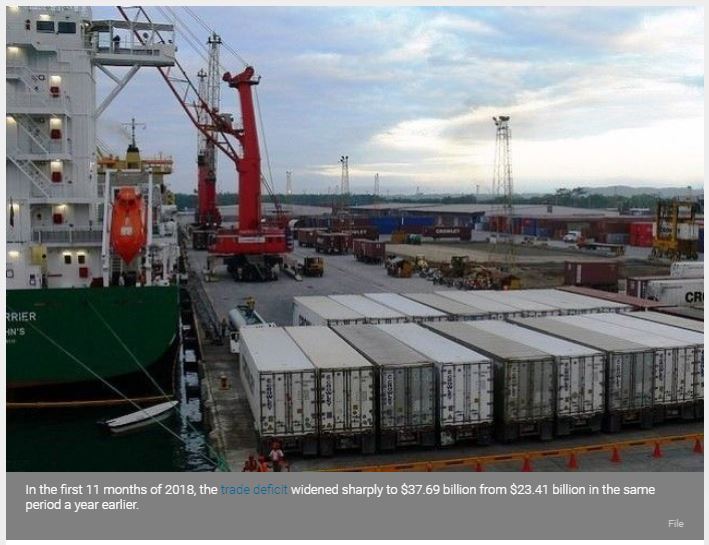Philippines: Trade gap widens in November 2018 as exports contract
MANILA, Philippines — An unexpected contraction in exports and the continued growth in imports widened the country’s trade deficit to $3.9 billion in November from the $3.28 billion gap a year earlier, the Philippine Statistics Authority (PSA) reported yesterday.
The November trade deficit, however, eased from the record high $4.21 billion gap logged in October.
PSA said exports fell 0.3 percent to $5.57 billion in November, the first decline since May last year.
Imports, meanwhile, continued to outpace exports, growing 6.8 percent to $9.47 billion in November last year. This growth, however, was a moderation from double-digit growth rates seen since April 2018.
In the first 11 months of 2018, the trade deficit widened sharply to $37.69 billion from $23.41 billion in the same period a year earlier.
PSA attributed the exports drop to declines in sales of four of the country’s top 10 export commodities: chemicals, ignition wiring sets, electronic products and coconut oil.
Socioeconomic Planning Secretary Ernesto Pernia said the decline in exports is a reflection of the moderation in global growth, which is seen to be muted this year.
“Moderation in global growth appears inevitable in 2019. Given a less encouraging global economic outlook, the country needs to ramp up the implementation of strategies outlined in the Philippine Export Development Plan 2018-2022,” he said in a statement.
The growth in imports, meanwhile, was attributed to growth in inbound shipments across all 10 major import commodities. These were the following: cereals and cereal preparations; mineral fuels, lubricants and related materials; iron and steel; other food and live animals; plastics; industrial machinery and equipment; telecommunication equipment and electrical machinery; miscellaneous manufactured articles; electronic products; and transport equipment.
Imports consisted mostly of raw materials and intermediate goods (38.6 percent of total import value) and semi-processed raw materials (33.9 percent of imports). Inbound shipments of capital goods, meanwhile, accounted for 31.9 percent of the total import value in November.
Pernia said to boost exports, support to micro, small and medium enterprises (MSMEs) is necessary to increase their participation in the global value chains.
“Simplifying loan processes, provision of financial literacy trainings, and facilitation of linkages between MSMEs and large corporations are some ways to spur the internationalization of MSMEs,” Pernia said.
Among the biggest risk to growth to the Philippine economy this year is the widening of the trade deficit and the current account deficit, which in turn, weakens the peso. The country’s trade deficit is currently the largest component of the current account deficit.
Pernia recognized this as a concern, noting there is a need to attract more foreign businesses in the country especially those that will transfer manufacturing facilities to the Philippines to serve both regional and ASEAN markets.
“A widening current account balance due to rising capital goods imports and anemic exports growth is a cause for concern. The widening gap emphasizes the need to reform legislation to allow foreign investments in firms catering to the domestic market, in addition to expanding their exporting activities,” Pernia said.
The fastest way to do this, he said, would be to fully implement the ease of Doing Business Act, which calls for the creation of the Expanded Anti-Red Tape Authority and the full operationalization of the National Single Window.
“Both measures will benefit existing firms, encouraging expansion, as well as attract new firms to do business in the country,” said Pernia.
Source: https://www.philstar.com/business/2019/01/11/1883965/trade-gap-widens-november-2018-exports-contract#pR8L9dhfhOSyY1Gx.99


 English
English




